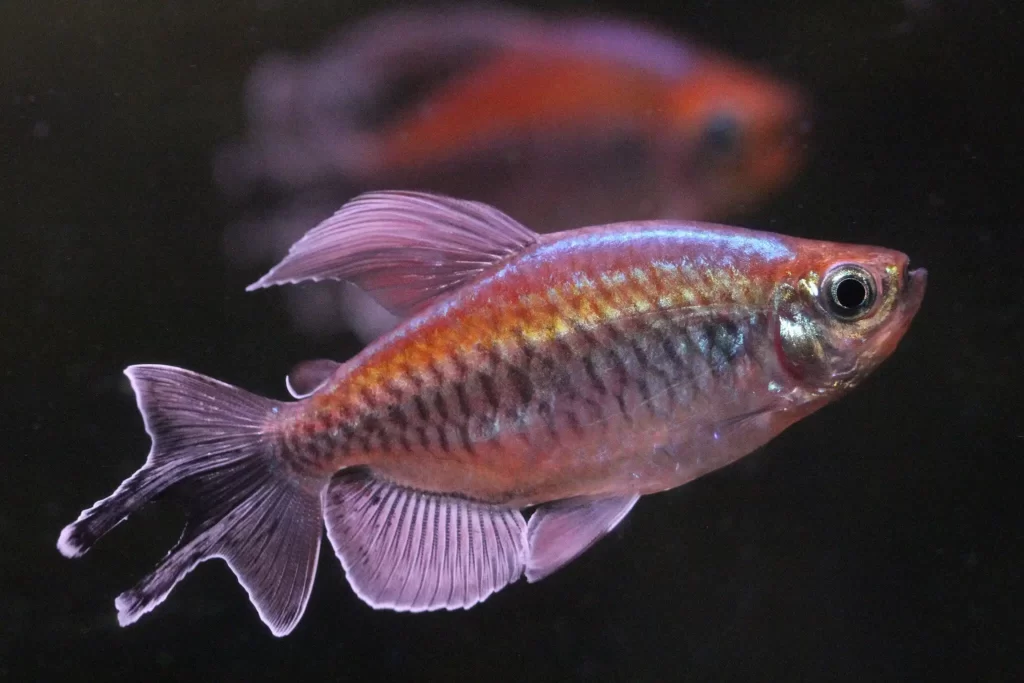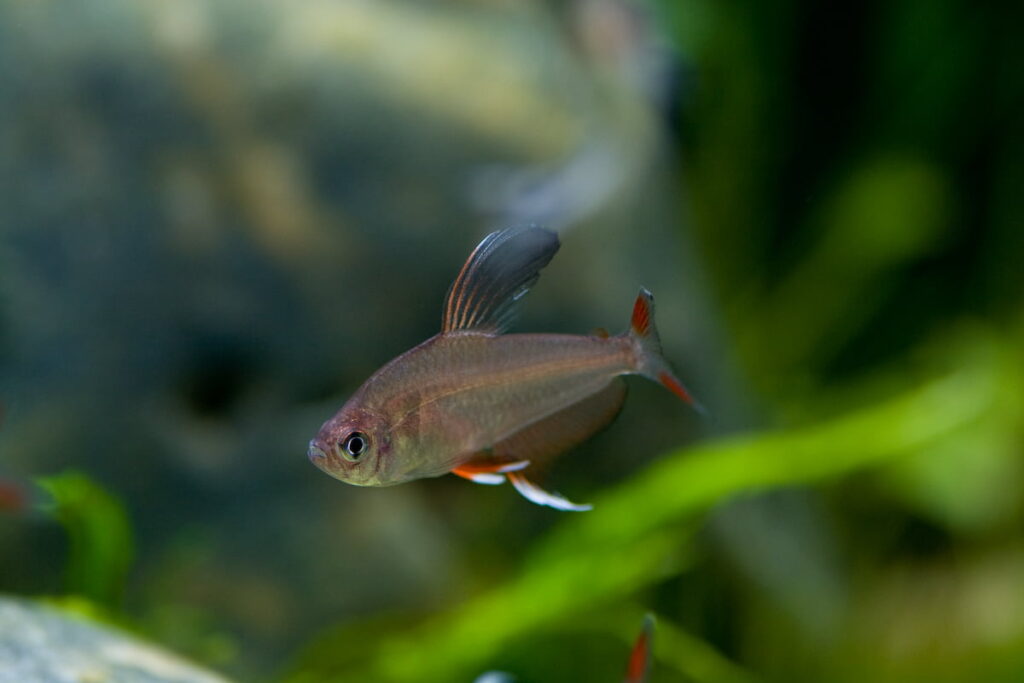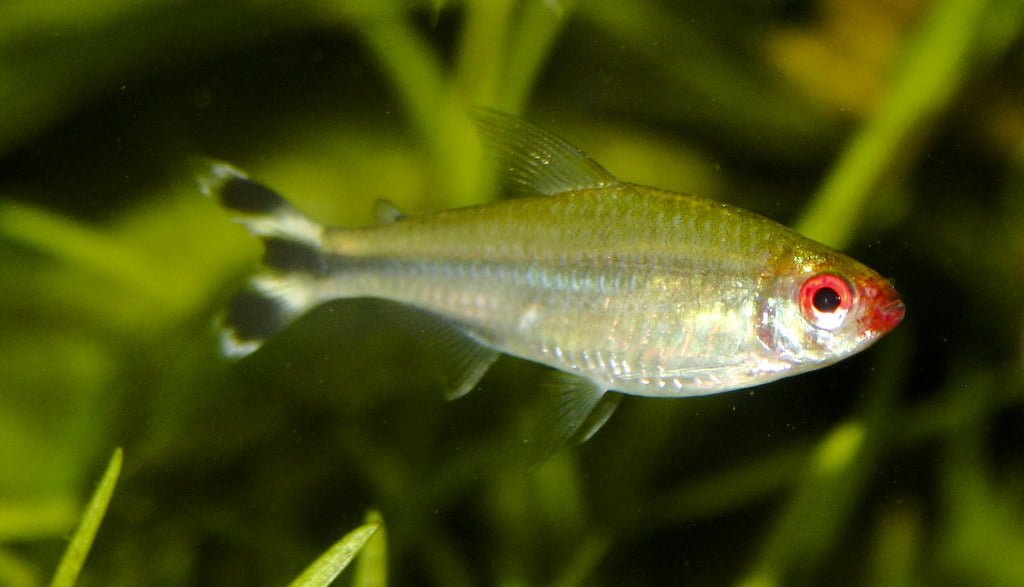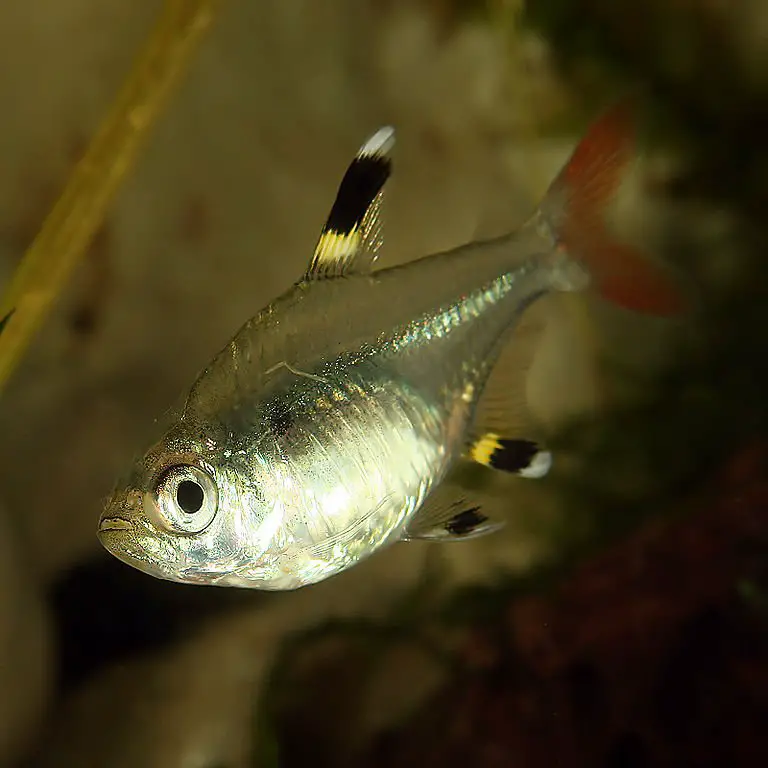Do you remember when you walk into the aquarium shop, and there is this tank that has beautiful fish with vibrant red and blue colors? Even more attractive when they are in an aquascaped tank? Most of you might be like, yeah, those are neon tetra, but most of the time, they are actually cardinal tetras. Cardinal tetras are one of the most beautiful freshwater fish you can ever find. They are very underrated and overshadowed by neon tetras. Maybe it’s because of the availability, price, and looks alike; I have seen people who have bought cardinal tetra, thinking it was neon tetra.
I see this problem mainly because of availability and look alike. Although they are not so rare, most of the time, when you go to the aquarium shop and ask about that red-blue shining color fish, chances are they are neon tetra, and they will tell you about neon tetra. However, when you visit next time, it might be cardinal tetra, but since they are so look alike unless you are very good observant or have good eyesight, chances are you will not notice the difference and assume it’s neon tetra.
Here, we will talk about how to differentiate cardinal tetra and neon tetra, care for cardinal tetra, and breeding cardinal tetras.
Introduction of Cardinal Tetra
Cardinal Tetra (Paracheirodon axelrodi) is a small, schooling freshwater fish. They are also known as red neon tetra. They have two color stripes that run horizontally; the top layer has a blue color, and the bottom layer has a red color. They are often confused with neon tetras; however, cardinal tetra and neon tetra are completely different species. It has a grayish tint in its upper body.
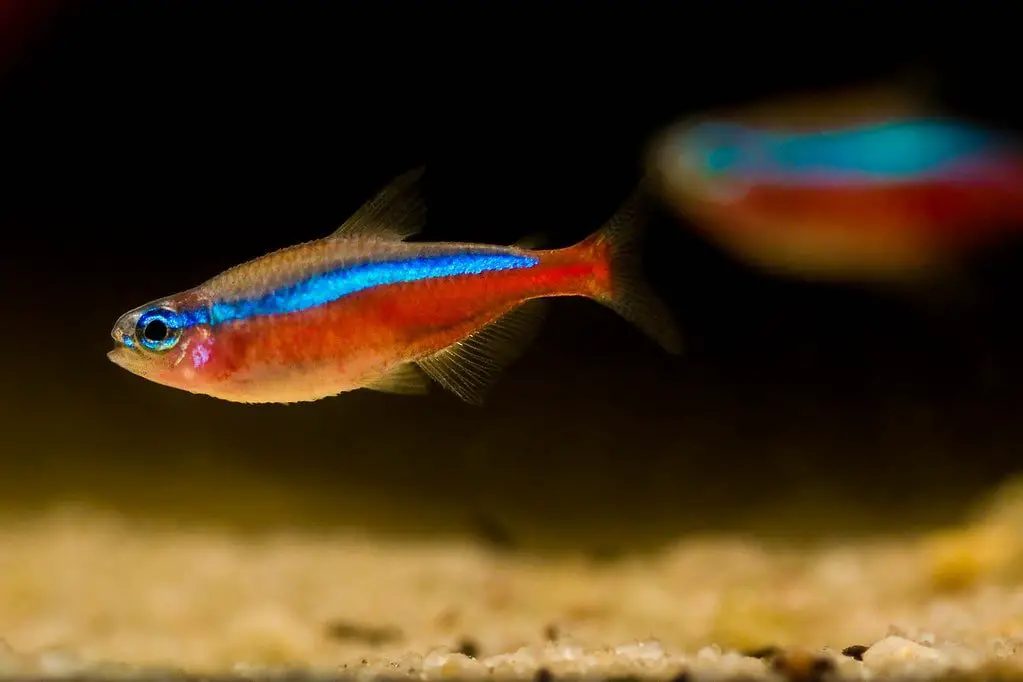
Cardinal tetras are mostly favored for aquascaped tank. They are challenging to breed in captivity, so most of them you buy are wild bred. In recent years, fish keepers are able to breed cardinal tetras in captivity.
There is this whole debate on whether wild bred or captivity bred is better. I will let you decide on which is better for yourself.
Classification
Kingdom: Animalia
Phylum: Chordata
Class: Actinopterygii
Order: Characifomes
Family: Characidae
Genus: Paracheirodon
Species: P. axelrodi
Origin and Habitat
Cardinal Tetras are South America’s freshwater fish. They are found in both black water and fresh, clean water, Rio Negro and Orinoco, respectively. These tetras are found in the shoals, submersed planted area with plenty of hiding places. They are usually found in steady, calm, flowing water.
Description of Cardinal Tetra
They are one of the most beautiful and rare color combinations you can find, i.e. blue and red. This is where you will learn to differentiate cardinal tetra and neon tetra. If you pay really close attention to them, you can distinguish them. They can be differentiated on the basis of markings and size.
Cardinal Tetra and Neon Tetra
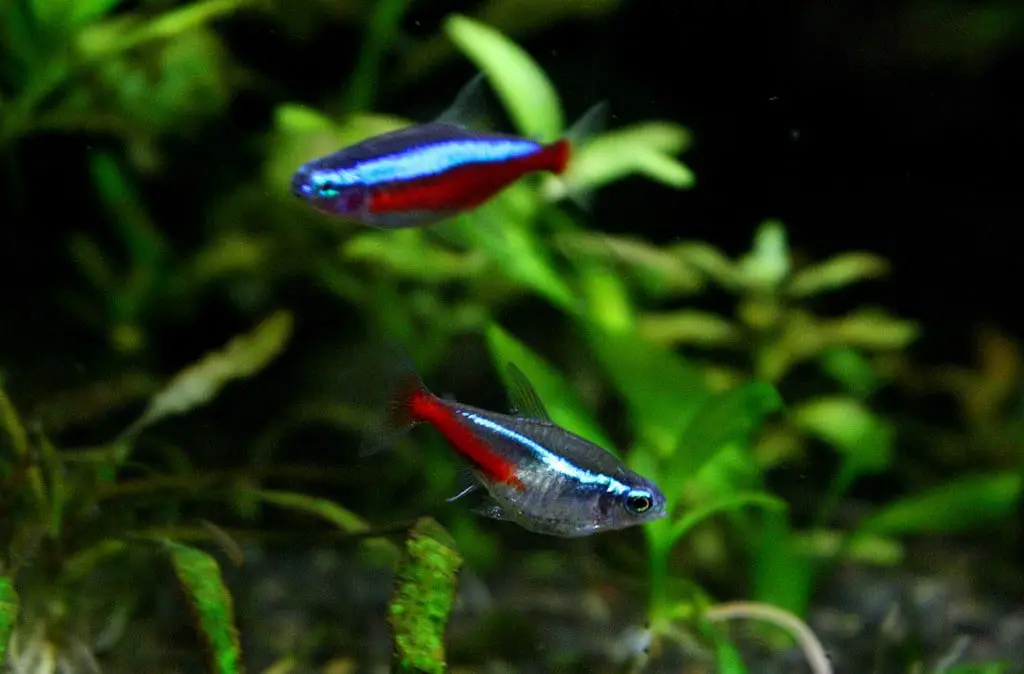
The first thing that will strike you about cardinal tetras is their body’s color. Cardinal tetras have luminous blue colors that run horizontally from nose to tail and bright, vivid red color at the ventral region that runs from gill’s area to tail. Their fins are transparent. Their gender cannot be differentiated on the basis of color as both males and females share the same body color.
Cardinal Tetra can grow up to 1.5-2 in (3.5-5cm).
Neon tetras have similar color appearance; however, they aren’t as bright as cardinal tetras. Blue color at the dorsal area isn’t thick, and red color at the dorsal area only starts from midway of the body. Their bodies are smaller compared to cardinal tetras. They grow up to one and a half inches.
You can find more about neon tetra here.
Numbers of Fish
They are schooling fish. When you buy, get at least six cardinal tetras. More the better, but always consider your tank size and buy them. Don’t overstock. When you buy them in a group, chances are you are getting both male and female. If it’s possible, get 1:3 (male to females ratio). This will reduce aggression between males and stress for females. If you have a larger tank, 25-100 of them will love amazing. They way they show off their color and school around the tank will catch anyone’s eye.
Lifespan
They live from 2-5 years in captivity. Five might be a stretch for some people, as achieving that goal is very difficult. Proper diet, water change, and constant water temperature are to be maintained for a happy, healthy fish. In the wild, they usually survive for a year.
Sex Differences
Cardinal tetras can’t be differentiated based on their color as both the sex have the same color. However, they can be separated based on body structure and pattern caused by the body structure.
Males have a slimmer body and have hook sticking out from the anal fin. Females have a larger body because they carry eggs. Because of the larger body, if you observe carefully, you can see the bending of blue-red stripes on the body of females.
Fish Difficulty
THEY ARE NOT BEGINNER FISH!!! If anybody tells you they are easy to keep, don’t believe them. Do your research! They are intermediate fish. When you buy cardinal tetras, always ask the seller if they were wild bred or captive-bred.
Wild type cardinal tetras are sensitive to captive/tank environment. They thrive in slightly more acidic water with lots of hiding places. They love blackwater with dim lighting, but people keep often keep them in an aquascaped tank. Due to this reason, wild cardinal tetras often die in the first few months and those who survive they aren’t as active as they should be. If you see you cardinal tetras hiding behind plants and filter; it’s because they are shy, stressed and isn’t able to adapt to the newer environment.
Captive-bred cardinal tetras can adapt to a newer environment with flexible water parameters. They are more active in aquascaped environment. They swim around in school.
Cardinal Tetra Diet
Cardinal tetras are very easy to feed. They eat anything that is given to them. They mostly eat floating food. As they are omnivores; for best health and color, live and frozen food such as bloodworm, or live foods such as brine shrimp and Daphnia, along with dried flakes. They can be fed once or twice a day. Feed only as much as they can eat within 1-2 minutes. Constant common fish food can dull the color.
Proper high-quality food can improve their immunity to fight against diseases.
Water Condition In the Tank
Cardinal tetras in the wild live in soft, slightly acidic, and warm temperature water but can extend to few changes in the parameter. Captive-bred ones are flexible to a newer environment.
Temperature
They love warmer temperatures. They thrive in temperatures that range from 76°F – 82°F (24.4°C – 27.7°C) (both wild and captive-bred). I always like to keep in between, i.e. 78.8°F (26°C).
pH and Hardness
They love acidic water. A pH of 6 would be ideal, but they can take as below as pH 4.5 and as high as 7.4. For wild bred, I keep them on the acidic side, i.e. pH 6, and for captive-bred, I keep them more on the neutral side (around pH 7).
Cardinal Tetra thrives in soft water with low mineral content. 2-8 dGH would be great for them.
Aquarium Setup for Cardinal Tetra
Now that you have detail information about the fish let’s look into how to set up the aquarium for Cardinal Tetra step by step. Here, we will be discussing the tank size, their diet, maintaining temperature, and other factors that you will need to look into in detail when setting up a tank.
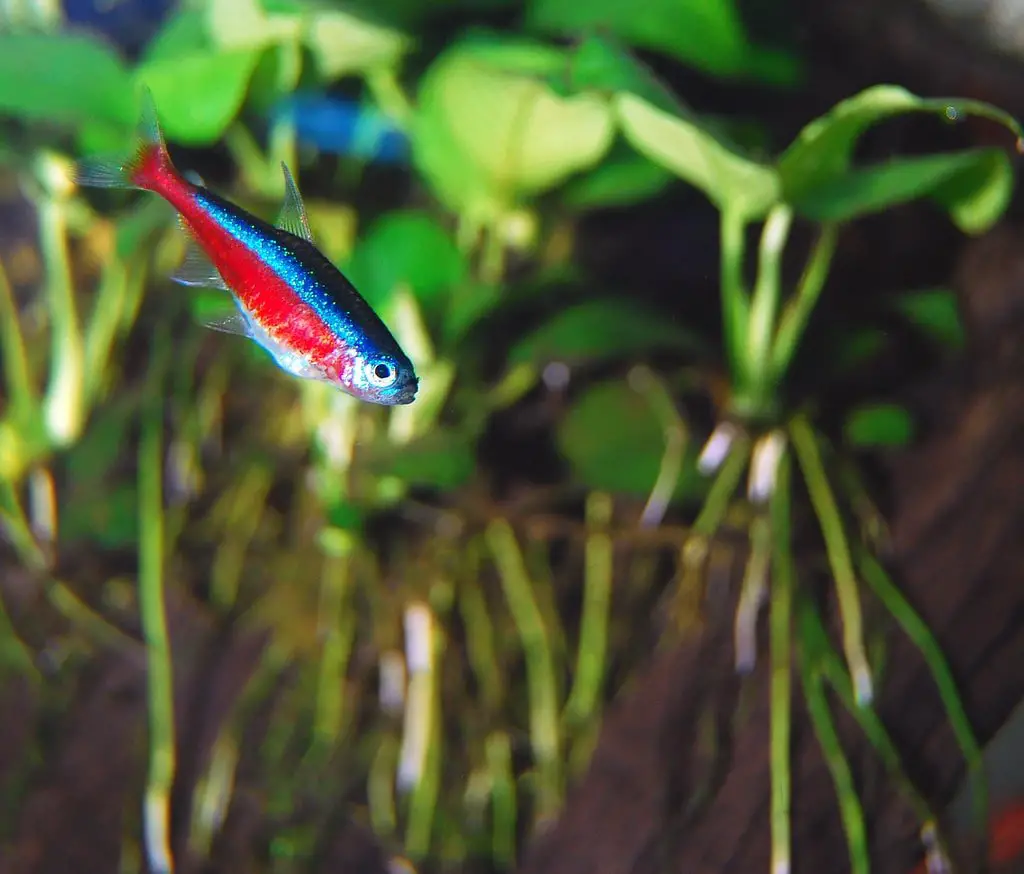
Tank Size
They are schooling fish, meaning they need space to swim around together. Meaning you will need a tank of 3 feet long and 2 feet wide. Of course, tank size depends on the number of fish you are keeping. I would recommend at least 15 gallons (37.8 liters) if you are going to have a small number of fish (6-10). Tank size; bigger, the better.
I wouldn’t recommend for nano tanks.
Filtration
Filtration is a large topic on its own. Any mechanical filter works for cardinal tetras as long as it does not have high speed/force water flow. Cardinal tetras tend to live in calm, steady low-speed water flow. However, I would recommend you to get a filter that has all the filter media in it. Like a canister filter. Adding a canister filter will increase your tank’s volume. And also, as the filter is big, it will house many of the beneficial bacteria in its biological media that will help to maintain your aquarium water.
Decoration
Few plastic decorations are alright with cardinal tetras, but I like my tank to mimic nature. Therefore, I keep my tank planted. Unlike other fish, cardinal tetras prefer planted tanks. For blackwater plants such as java fern, anubias and amazon sword would be great with the addition of floating plants such as amazon frogbit or giant duckweeds. Add driftwoods as well and create plenty of areas to hide. This will help stressed fish to hide.
If you are going aquascaped tank, you have plenty of plants to explore. But remember to have plenty of spaces to hide.
Substrate
They don’t have a preference of substrate as they hardly swim at the bottom, but for blackwater, add white color substrate. This makes the blackwater tank more appealing. Otherwise, you can go with the black substrate as well.
Lighting
For blackwater, chose dim lights. The floating plants will mimic nature as if few sun’s rays are entering the tank. In the dim light, their body’s color will be even brighter and colorful.
Water change
We change water to remove ammonia and nitrite. They are toxic to fish. Ammonia is built in two ways when fish produce waste more (overstock compared to tank size) than beneficial bacteria can convert to nitrate or when you are overfeeding.
It doesn’t matter if it’s blackwater or clear water, you can do a 50% water change every week. But before you water change, check your water parameters, and after the water change, recheck it. If you still find ammonia and nitrite present, do more water changes.
Even though I recommend 50% water change every week, water change depends upon tank size and number of fish in it. If it is densely planted and well stocked with respect to tank size, a weekly 50% water change would be ideal. If you have a large tank (30 gallons) with 6-10, you can do once every three weeks or so.
Check water parameters and note them down and find how much water change is necessary for you. Set your own personal routine and continue with it until there are changes in the tank.
Tank Mates
They are peaceful fish; however, for wild bred, I would only do species tank, but you can keep them with other tetras as well. If it’s captive-bred, you can keep with similar fish without worrying much about parameters.
Out of all fish out there, most people want to know is, can you keep cardinal tetras with neon tetras? To that answer, I would say yes and no. What does that mean? Well, both species have very different temperature settings. Neon tetras live in colder water 68–82°F (20 and 28°C), and cardinal tetras live in warmer water. Sure, you can say, let’s let them meet in middle 77°F (25°C) but let me ask you a question, are they living or surviving at that temperature?
So what can we keep? Danios, other tetras of similar temperature range, rasboras, dwarf gouramis, guppies, Cory catfish, Zebra Loaches, shrimps, snails, etc. I personally would recommend Cory catfish as cardinal tetras don’t dwell bottom layer of the tank, so Cory catfish will eat any extra food that is lying at the bottom of the tank. Any bottom dwellers would be a great addition to the tank.
Don’t keep anything that cardinal tetras can shallow, such as fry of cardinal tetras or any other fish’s fry. They live with similar size fish, and anything bigger than them will prey on them. Aggressive fish will hunt them.
Breeding Cardinal Tetra
Cardinal tetras are very hard to breed. In past years, few keepers were able to breed cardinal tetras, but lately, many keepers are able to breed them. You will need to separate a pair from the community as other cardinal tetras will feed on the fry and eggs.
Cardinal tetras are egg scattered. For breeding, you need to set up a tank with all right conditions, i.e. pH, temperature, hardness, lighting, and plants.
Set up a tank with a pH of 6.5 or below. More acidic than this, the better. Have a hardness of 2-3 dGH. A constant warm temperature of 80.6°F (27°C) will give a more success rate. Stock the tank with plants with widespread leaves. Add some floating plants with dim lighting. Get a divider that separates the top and bottom layer so the eggs can be out of reach from parents. Spawning usually occurs during the evening or night.
Add male and female. Pick the fastest female and brightest male. If all the requirements are met, the female’s body will grow much larger due to eggs. Females will allow the male to swim alongside of her. They will mostly swim around plants. Females will release eggs, and males will release sperm. Females will lay from 100-500 eggs.
After spawning, remove the parents and keep them back into their original tank.
Filter and Breeding Tank Condition
Since the breeding tank already has plants in it, plants will provide enough space for fry to hide. Fry are very sensitive, so water parameters should be maintained with a routine water change. Careful with water change as fluctuation can kill fry. Large filters can suck fry inside it, leading to death. Air pumps would do a better job of circulating water and oxygen. Do not stress fry with speedy water and change in water parameters.
Eggs and Fry
Eggs hatch within 48-72hr. It usually takes three days for them to hatch. They will be free swimmers within 4-7 days. At this stage of fry, fry are sensitive to light, so the fry tank should be as dim as possible. Increase light intensity on a gradual basis to normal conditions.
Within hatch, you don’t need to hurry and feed them. They have their yolk sac, which can feed them up to 3-4 days. Then they should be fed on infusoria (ciliates, euglenoids, protozoa, unicellular algae, and small invertebrates) food for the first few weeks. As they get bigger, broken down adult food can be provided. Observe how they react to foods. Some might be picky, or they might find food too big to consume. If they don’t eat adult food, feed them infusoria then later again after a few days try adult food.
After 8-12 weeks, they will resemble their adult form giving vibrant blue and vivid red color. Females will mature around nine months to lay eggs.
Diseases And Cure
Cardinal tetras are very resistance towards diseases. That doesn’t mean they don’t get sick. If you have all the parameters checked and provide healthy food, you don’t need to worry. However, if you are lazy and maintain your tank every once in a few months, then you will encounter problems.
Getting your cardinal tetras sick is the last thing you want. For those beautiful colors, you got them will disappear within a few days, leaving this nasty looking fish.
Always get your fish quarantine tank for 1-2 weeks to see if they are already sick or is carry parasite. Provide a healthy diet and a weekly 50% water change. If they don’t get sick in this period of time, they are safe to put in your tank.
If they get sick while they are in quarantine, first identify the problem and start the treatment. In case your fish get sick when they are in the main tank, first identify the diseases, then, the source of the problem (it could be because of new fish that you didn’t quarantine, other fish are picking up on the sick fish, bad water parameters or wrong tankmates). Separate the fish to a small (hospital tank) tank so it will be easier to treat and monitor.
If the treatment is going to be on the main tank, remove active carbon.
Summary
Cardinal tetras might look-alike like neon tetras, but in my opinion, cardinal tetras are more beautiful than neon tetras. They are more vibrant in color and larger in size. Size might not be a concern when you are looking at the fish from a far distance, but you can surely notice the color. However, cardinal tetras are more expensive than neon tetras. If you buy 6 cardinal tetras, at the same amount, you can buy 12-18 neon tetras. I personally prefer cardinal tetras over neon tetras.
You can go with both wild and captive-bred cardinal tetras, but wild bred are more sensitive and hard to keep in captivity, and captive-bred are more flexible to water parameters, so for that reason, I prefer captive-bred cardinal tetras.
Cardinal Tetras are not beginner-friendly fish. They need slightly acidic, soft, and warm water temperature and prefer blackwater with plants. They swim at the top and middle layer of the tank, and for that reason getting bottom dwellers would complete the tank. Bottom dwellers can help with leftover foods too.
Notes
Don’t get less than 6. This will stress the fish and cause aggression between them.
They are resistant to most diseases, but that doesn’t mean they don’t get sick. Do your water change and feed them healthy foods.
Always ask the seller if they are wild bred or captive-bred.
When they are stressed or shy, they hide behind plants and filters.
